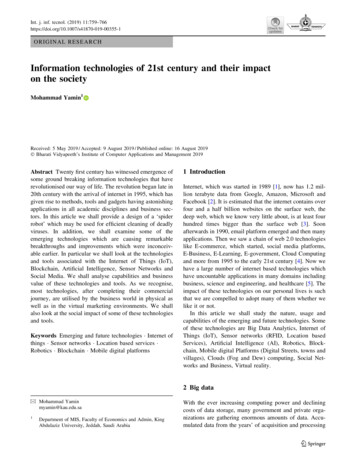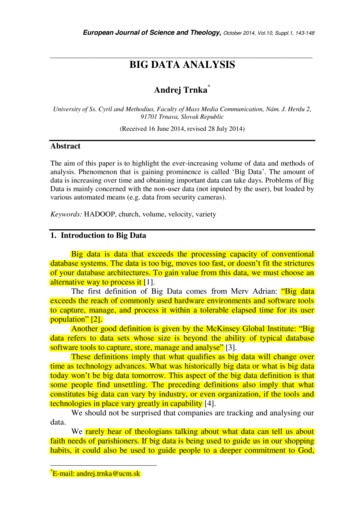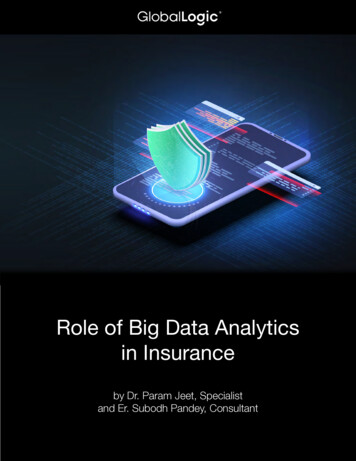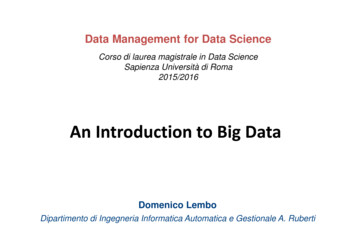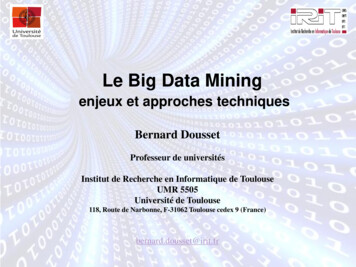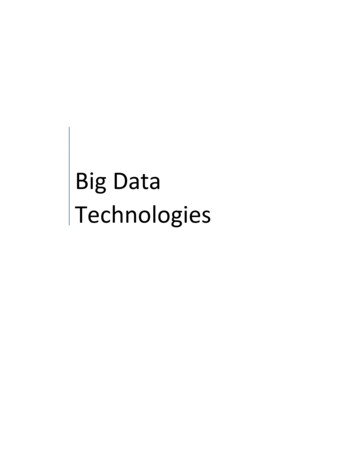
Transcription
Big DataTechnologies
Big Data Technologies Syllabus1. Introduction to Big Data1.1Big data overview1.2Background of data analytics1.3Role of distributed system in big data1.4Role of data scientist1.5Current trend in big data analytics2. Google file system2.1Architecture2.2Availability2.3Fault tolerance2.4Optimization of large scale data3. Map Reduce Framework3.1Basics of functional programming3.2Fundamentals of functional programming3.3Real world problems modelling in functional style3.4Map reduce fundamentals3.5Data flow (Architecture)3.6Real world problems3.7Scalability goal3.8Fault tolerance3.9Optimization and data locality3.10 Parallel efficiency of map reduce4. NoSQL4.1Structured and unstructured data4.2Taxonomy of NOSQL implementation4.3Discussion of basic architecture of Hbase, Cassandra and MongoDb5. Searching and indexing big data5.1Full text indexing and searching5.2Indexing with Lucene5.3Distributed searching with elastic search6. Case study: Hadoop6.1Introduction to Hadoop environment6.2Data flow6.3Hadoop I/O6.4Query language of Hadoop6.5Hadoop and amazon cloud
Table of ContentsS.N.Chapter NamePage No.1.Big data technologies3-112.Google file system12-283.Map Reduce framework4.NOSQL5.Searching and Indexing6.Case Study: Hadoop29-4041-6364-7172-77
Chapter 1: Big Data TechnologiesIntroduction Big data is a term applied to a new generation of software, applications, and system andstorage architecture.It designed to provide business value from unstructured data.Big data sets require advanced tools, software, and systems to capture, store, manage,and analyze the data sets,All in a timeframe big data preserves the intrinsic value of the data.Big data is now applied more broadly to cover commercial environments.Four distinct applications segments comprise the big data market.Each with varying levels of need for performance and scalability.The four big data segments are:1) Design (engineering collaboration)2) Discover (core simulation – supplanting physical experimentation) 3)Decide (analytics).4) Deposit (Web 2.0 and data warehousing)Why big data? Three trends disrupting the database status quo– Big Data, Big Users, and CloudComputingBig Users: Not that long ago, 1,000 daily users of an application was a lot and 10,000 wasan extreme case. Today, with the growth in global Internet use, the increased numberof hour’s users spend online, and the growing popularity of smartphones and tablets, it'snot uncommon for apps to have millions of users a day.Big Data: Data is becoming easier to capture and access through third parties such asFacebook, D&B, and others. Personal user information, geo location data, social graphs,user-generated content, machine logging data, and sensor-generated data are just a fewexamples of the ever-expanding array of data being captured.Cloud Computing: Today, most new applications (both consumer and business) use athree-tier Internet architecture, run in a public or private cloud, and support largenumbers of users.Who uses big data?Facebook, Amazon, Google, Yahoo, New York Times, twitter and many more
Data analytics Big data analytics is the process of examining large amounts of data of a variety of types.Analytics and big data hold growing potential to address longstanding issues in criticalareas of business, science, social services, education and development. If this power is tobe tapped responsibly, organizations need workable guidance that reflects the realitiesof how analytics and the big data environment work.The primary goal of big data analytics is to help companies make better businessdecisions.Analyze huge volumes of transaction data as well as other data sources that may be leftuntapped by conventional business intelligence (BI) programs. Big data analytics can be done with the software tools commonly used as part ofadvanced analytics disciplines. Such as predictive analysis and data mining. But the unstructured data sources used for big data analytics may not fit in traditionaldata warehouses. Traditional data warehouses may not be able to handle the processing demands posedby big data. The technologies associated with big data analytics include NoSQL databases, Hadoopand MapReduce.Known about these technologies form the core of an open source software frameworkthat supports the processing of large data sets across clustered systems.big data analytics initiatives includeinternal data analytics skillshigh cost of hiring experienced analytics professionals,challenges in integrating Hadoop systems and data warehousesBig Analytics delivers competitive advantage in two ways compared to the traditionalanalytical model.First, Big Analytics describes the efficient use of a simple model applied to volumes ofdata that would be too large for the traditional analytical environment.Research suggests that a simple algorithm with a large volume of data is more accuratethan a sophisticated algorithm with little dataThe term “analytics” refers to the use of information technology to harness statistics,algorithms and other tools of mathematics to improve decision-making.Guidance for analytics must recognize that processing of data may not be linear.May involve the use of data from a wide array of sources.
Principles of fair information practices may be applicable at different points in analyticprocessing.Guidance must be sufficiently flexible to serve the dynamic nature of analytics and therichness of the data to which it is applied.The power and promise of analytics Big Data Analytics to Improve Network Security.Security professionals manage enterprise system risks by controlling access to systems,services and applications defending against external threats.Protecting valuable data and assets from theft and loss.Monitoring the network to quickly detect and recover from an attack.Big data analytics is particularly important to network monitoring, auditing and recovery.Business Intelligence uses big data and analytics for these purposes.Reducing Patient Readmission Rates (Medical data)Big data to address patient care issues and to reduce hospital readmission rates.The focus on lack of follow-up with patients, medication management issues andinsufficient coordination of care.Data is preprocessed to correct any errors and to format it for analysis.Analytics to Reduce the Student Dropout Rate (Educational Data)Analytics applied to education data can help schools and school systems betterunderstand how students learn and succeed.Based on these insights, schools and school systems can take steps to enhance educationenvironments and improve outcomes.Assisted by analytics, educators can use data to assess and when necessary re-organizeclasses, identify students who need additional feedback or attention.Direct resources to students who can benefit most from them.
The process of analyticsThis knowledge discovery phase involves Gathering data to be analyzed.Pre-processing it into a format that can be used.Consolidating (more certain) it for analysis, analyzing it to discover what it may reveal.And interpreting it to understand the processes by which the data was analyzed and howconclusions were reached.Acquisition –(process of getting something)Data acquisition involves collecting or acquiring data for analysis.Acquisition requires access to information and a mechanism for gathering it.Pre-processing –: Data is structured and entered into a consistent format that can be analyzed.Pre-processing is necessary if analytics is to yield trustworthy (able to trusted), usefulresults.Places it in a standard format for analysis.Integration –: Integration involves consolidating data for analysis.Retrieving relevant data from various sources for analysisEliminating redundant data or clustering data to obtain a smaller representative sample.Clean data into its data warehouse and further organizes it to make it readily useful forresearch.distillation into manageable samplesAnalysis – Knowledge discovery involves Searching for relationships between data items in a database, or exploring data in searchof classifications or associations.Analysis can yield descriptions (where data is mined to characterize properties) orpredictions (where a model or set of models is identified that would yield predictions).Analysis based on interpretation, organizations can determine whether and how to acton them.
Data scientistData scientists include Data capture and InterpretationNew analytical techniquesCommunity of SciencePerfect for group workTeaching strategiesData scientist requires wide range of skills Business domain expertise and strong analytical skillsCreativity and good communications.Knowledgeable in statistics, machine learning and data visualizationAble to develop data analysis solutions using modeling/analysis methods and languagessuch as Map-Reduce, R, SAS, etc.Adept at data engineering, including discovering and mashing/blending large amountsof data.Data scientists use an investigative computing platform To bring un-modeled data.Multi-structured data, into an investigative data store for experimentation.Deal with unstructured, semi-structured and structured data from various source.Data scientist helps broaden the business scope of investigative computing in three areas:New sources of data – supports access to multi-structured data.New and improved analysis techniques – enables sophisticated analytical processing of multistructured data using techniques such as Map-Reduce and in-database analytic functions.
Improved data management and performance – provides improved price/performance forprocessing multi-structured data using non-relational systems such as Hadoop, relationalDBMSs, and integrated hardware/software.Goal of data analytics is the role of data scientist Recognize and reflect the two-phased nature of analytic processes.Provide guidance for companies about how to establish that their use of data forknowledge discovery is a legitimate business purpose.Emphasize the need to establish accountability through an internal privacy program thatrelies upon the identification and mitigation of the risks the use of data for analytics mayraise for individuals.Take into account that analytics may be an iterative process using data from a variety ofsources.Current trend in big data analytics Iterative process (Discovery and Application) In general:Analyze the unstructured data (Data analytics) development of algorithm (Data analytics) Data Scrub (Data engineer) Present structured data (relationship, association) Data refinement (Data scientist) Process data using distributed engine. E.g. HDFS (S/W engineer) and write to No-SQL DB(Elastic search, Hbase, MangoDB, Cassandra, etc) Visual presentation in Application s/w. QC verification. Client release.Questions:Explain the term "Big Data". How could you say that your organization suffers from Big Dataproblem?Big data are those data sets with sizes beyond the ability of commonly used software tools tocapture, curate, manage, and process the data within a tolerable elapsed time Big data is theterm for a collection of data sets so large and complex that it becomes difficult to process usingon-hand database management tools or traditional data processing applications.Big Data is often defined along three dimensions- volume, velocity and variety.
Big data is data that can be manipulated (slices and diced) with massive speed.Big data is the not the standard fare that we use, but the more complex and intricatedata sets. Big data is the unification and integration of diverse data sets (kill the data ghettos). Big data is based on much larger amount of data sets than what we're used to and howthey can be resolved with both speed and variety. Big data extrapolates the information in a different (three dimensional) way.Data sets grow in size in part because they are increasingly being gathered by ubiquitousinformation-sensing mobile devices, aerial sensory technologies (remote sensing), softwarelogs, cameras, microphones, radio-frequency identification readers, and wireless sensornetworks. The world's technological per-capita capacity to store information has roughlydoubled every 40 months since the 1980s; as of 2012, every day 2.5 quintillion (2.5 1018) bytesof data were created. As the data collection is increasing day by day, is difficult to work withusing most relational database management systems and desktop statistics and visualizationpackages, requiring instead "massively parallel software running on tens, hundreds, or eventhousands of servers. The challenges include capture, duration, storage, search, sharing,transfer, analysis, and visualization. So such large gathering of data suffers the organizationforces the need to big data management with distributed approach.Explain the role of distributed system in Big Data. You can provide illustrations with your casestudy or example if you like.A distributed system is a collection of independent computers that appears to its users as a singlecoherent system. A distributed system is one in which components located at networkedcomputers communicate and coordinate their actions only by passing messages. Distributedsystem play an important role in managing the big data problems that prevails in today’s world.In the distributed approach, data are placed in multiple machines and are made available to theuser as if they are in a single system. Distributed system makes the proper use of hardware andresources in multiple location and multiple machines.Example: How google manages data for search engines?Advances in digital sensors, communications, computation, and storage have created hugecollections of data, capturing information of value to business, science, government, and society.For example, search engine companies such as Google, Yahoo!, and Microsoft have created anentirely new business by capturing the information freely available on the World Wide Web andproviding it to people in useful ways. These companies collect trillions of bytes of data every day.Due to accumulation of large amount of data in the web every day, it becomes difficult tomanage the document in the centralized server. So to overcome the big data problems, searchengines companies like Google uses distributed server. A distributed search engine is a searchengine where there is no central server. Unlike traditional centralized search engines, work such
as crawling, data mining, indexing, and query processing is distributed among several peers indecentralized manner where there is no single point of control. Several distributed servers areset up in different location. Challenges of distributed approach like heterogeneity, Scalability,openness and Security are properly managed and the information are made accessed to the userfrom nearby located servers. The mirror servers performs different types of caching operationas required. A system having a resource manager, a plurality of masters, and a plurality of slaves,interconnected by a communications network. To distribute data, a master determined that adestination slave of the plurality slaves requires data. The master then generates a list of slavesfrom which to transfer the data to the destination slave. The master transmits the list to theresource manager. The resource manager is configured to select a source slave from the listbased on available system resources. Once a source is selected by the resource manager, themaster receives an instruction from the resource manager to initiate a transfer of the data fromthe source slave to the destination slave. The master then transmits an instruction to commencethe transfer.Explain the implications of "Big Data" in the current renaissance of computing.In 1965, Intel cofounder Gordon Moore observed that the number of transistors on anintegrated circuit had doubled every year since the microchip was invented. Data density hasdoubled approximately every 18 months, and the trend is expected to continue for at least twomore decades. Moore's Law now extends to the capabilities of many digital electronic devices.Year after year, we're astounded by the implications of Moore's Law — with each new versionor update bringing faster and smaller computing devices. Smartphones and tablets now enableus to generate and examine significantly more content anywhere and at any time. The amountof information has grown exponentially, resulting in oversized data sets known as Big Data. Datagrowth has rendered traditional management tools and techniques impractical to producemeaningful results quickly. Computation tasks that used to take minutes now take hours ortimeout altogether before completing. To tame Big Data, we need new and better methods toextract actionable insights. According to recent studies, the world's population will produce andreplicate 1.8 zeta bytes (or 1.8 trillion gigabytes) of data in 2011 alone — an increase of ninetimes the data produced five years ago. The number of files or records (such as photos, videos,and e-mail messages) is projected to grow 75 times, while the staff tasked with managing thisinformation is projected to increase by only 1.5 times. Big data is likely to be increasingly part ofIT world. Computation of Big data is difficult to work with using most relational databasemanagement systems and desktop statistics and visualization packages, requiring instead"massively parallel software running on tens, hundreds, or even thousands of servers" Big dataresults in moving to constant improvement in traditional DBMS technology as well as newdatabases like NoSQL and their ability to handle larger amounts of data To overcome thechallenges of big data, several computing technology have been developed. Big Data technologyhas matured to the extent that we're now able to produce answers in seconds or minutes —results that once took hours or days or were impossible to achieve using traditional analyticstools executing on older technology platforms. This ability allows modelers and businessmanagers to gain critical insights quickly.
Chapter 2: Google file systemIntroduction Google File System, a scalable distributed file system for large distributed data-intensiveapplications.Google File System (GFS) to meet the rapidly growing demands of Google’s dataprocessing needs.GFS shares many of the same goals as other distributed file systems such asperformance, scalability, reliability, and availability.GFS provides a familiar file system interface.Files are organized hierarchically in directories and identified by pathnames.Support the usual operations to create, delete, open, close, read, and write files.Small as well as multi-GB files are common.Each file typically contains many application objects such as web documents.GFS provides an atomic append operation called record append. In a traditional write,the client specifies the offset at which data is to be written.Concurrent writes to the same region are not serializable.GFS has snapshot and record append operations.Google (snapshot and record append) The snapshot operation makes a copy of a file or a directory.Record append allows multiple clients to append data to the same file concurrently whileguaranteeing the atomicity of each individual client’s append.It is useful for implementing multi-way merge results.GFS consist of two kinds of reads: large streaming reads and small random reads.In large streaming reads, individual operations typically read hundreds of KBs, morecommonly 1 MB or more.A small random read typically reads a few KBs at some arbitrary offset.Common goals of GFS PerformanceReliabilityScalabilityAvailabilityOther GFS concepts Component failures are the norm rather than the exception.
File System consists of hundreds or even thousands of storage machines built frominexpensive commodity parts. Files are Huge. Multi-GB Files are common.Each file typically contains many application objects such as web documents. Append, Append, Append.Most files are mutated by appending new data rather than overwriting existing data. Co-DesigningCo-designing applications and file system API benefits overall system by increasingflexibility. Why assume hardware failure is the norm?- It is cheaper to assume common failure on poor hardware and account for it,rather than invest in expensive hardware and still experience occasional failure.- The amount of layers in a distributed system (network, disk, memory, physicalconnections, power, OS, application) mean failure on any could contribute to datacorruption.GFS Assumptions System built from inexpensive commodity components that failModest number of files – expect few million and 100MB size. Did not optimize forsmaller files.2 kinds of reads – :- large streaming read (1MB)- small random reads (batch and sort)High sustained bandwidth chosen over low latencyGFS Interface GFS – familiar file system interfaceFiles organized hierarchically in directories, path namesCreate, delete, open, close, read, write operationsSnapshot and record append (allows multiple clients to append simultaneously - atomic)GFS Architecture (Analogy)On a single machine file system: An upper layer maintains the metadata
A lower ie disk stores the data in units called blocksIn the GFS A master process maintains the metadataA lower layer (ie set of chunkservers) stores data in units called “chunks”What is a chunk? Analogous to block, except largerSize 64MBStored on chunkserver as fileChunk handle ( chunk file name) used to reference chunkChunk replicated across multiple chunkserversNote: There are hundreds of chunkservers in GFS cluster distributed over multiple racksWhat is a master? A single process running on a separate machineStores all metadata- File namespace- File to chunk mappings- Chunk location information
- Access control informationChunk version numbersA GFS cluster consists of a single master and multiple chunk-servers and is accessed by multipleclients. Each of these is typically a commodity Linux machine.It is easy to run both a chunk-server and a client on the same machine.As long as machine resources permit, it is possible to run flaky application code is acceptable.Files are divided into fixed-size chunks.Each chunk is identified by an immutable and globally unique 64 bit chunk assigned by the masterat the time of chunk creation.Chunk-servers store chunks on local disks as Linux files, each chunk is replicated on multiplechunk-servers.The master maintains all file system metadata. This includes the namespace, access controlinformation, mapping from files to chunks, and the current locations of chunks.It also controls chunk migration between chunk servers.The master periodically communicates with each chunk server in Heart Beat messages to give itinstructions and collect its state.Master - Server CommunicationMaster and chunkserver communicate regularly to obtain state: Is chunkserver down?Are there disk failures on chunkserver?Are any replicas corrupted?Which chunk replicas do chunkserver store?Master sends instructions to chunkserver: Delete existing chunkCreate new chunkServing requests: Client retrieves metadata for operation form masterRead/write data flows between client and chunkserverSingle master is not bottleneck because its involvement with read/write operations is minimizedRead algorithm Application originates the read requestGFS client translates the request from (filename, byte range) - (filename, chunk, index), andsends it to masterMaster responds with chunk handle and replica locations (i.e chunkservers where replicas arestored)
Client picks a location and sends the (chunk handle, byte range) request to that locationChunkserver sends requested data to the clientClient forwards the data to the applicationWrite Algorithm Application originates with requestGFS client translates request from (filename, data) - (filename, chunk index) and sendsit to masterMaster responds with chunk handle and (primary secondary) replica locationsClient pushes write data to all locations. Data is stored in chunkservers’ internal buffer Client sends write command to primary
Primary determines serial order for data instances stored in its buffer and writes theinstances in that order to the chunkPrimary sends order to the secondaries and tells them to perform the writeSecondaries responds to the primaryPrimary responds back to the clientIf write fails at one of chunkservers, client is informed and rewrites the write.Record append algorithm Important operations at Google:- Merging results from multiple machines in one file- Using file as producer – consumer queue1.2.3.4.5.Application originates record append requestGFS client translates request and send it to masterMaster responds with chunk handle and (primary secondary) replica locationsClient pushes write data to all locationsPrimary checks if record fits in specified chunk 6. If record does fit, then the primary: Pads the chunk- Tells secondaries to do the same- And informs the client- Client then retries the append with the next chunk7. If record fits, the primary:- Appends the record- Tells secondaries to do the same- Receives responses from secondaries- And sends final response to the clientGFS fault tolerance Fast recovery: master and chunkservers are designed to restart restore state in a fewsecondsChunk replication: across multiple machines, across multiple racks Master mechanisms:- Log of all changes made to metadata- Periodic checkpoints of the log- Log and checkpoints replication on multiple machines- Master state is replicated on multiple machines- “Shadow” masters for reading data if “real” master is downData integrity
-Each chunk has an associated checksumMetadataThree types: File and chunk namespacesMapping from files to chunksLocation of each chunk’s replicasInstead of keeping track of chunk location info- Poll: which chunkserver has which replicaMaster controls all chunkplacement- Disks may go bad, chunkserver errors etc.Consistency model Write – data written at application specific offset Record append – data appended automatically at least once at offset of GFS’s choosing(Regular Append – write at offset, client thinks is EOF) GFS-Applies mutation to chunk in some order on all replicasUses chunk version numbers to detect stale replicasGarbage collected, updated next time contact masterAdditional featureschecksumming–regularhandshakemaster- Data only lost if all replicas lost before GFS can reactWrite control and data flowandchunkservers,
Replica placement GFS cluster distributed across many machine racksNeed communication across several network switchesChallenge to distribute dataChunk replica- Maximize data reliability- Maximize network bandwidth utilization Spread replicas across racks (survives even if entire rack offline) R can exploit aggregate bandwidth of multiple racks Re-replicate- When number of replicas fall below goal:- Chunkserver unavailable, corrupted etc.- Replicate based on priority Rebalance- Periodically moves replicas for better disk space and load balancing- Gradually fills up new chunkserver- Removes replicas from chunkservers with below average spaceGarbage collection When delete file, file renamed to hidden name including delete timestampDuring regular scan of file namespace- Hidden files removes if existed 3 days- Until then can be undeleted- When removes, in memory metadata erased- Orphaned chunks identified and erased- With HeartBeat message, chunkserver/master exchange info about files, mastertells chunkserver about files it can delete, chunkserver free to deleteAdvantages- Simple, reliable in large scale distributed systemChunk creation may success on some servers but not othersReplica deletion messages may be lost and resentUniform and dependable way to clean up replicas- Merges storage reclamation with background activities of masterDone in batches
Done only when master free- Delay in reclaiming storage provides against accidental deletionDisadvantages- Delay hinders user effort to fine tune usage when storage tight- Applications that create/delete may not be able to reuse space right awayExpedite storage reclamation if file explicitly deleted againAllow users to apply different replication and reclamation policiesShadow masterMaster replication Replicated for reliabilityOne master remains in charge of all mutations and background activitiesIf fails, start instantlyIf machine or disk mails, monitor outside GFS starts new master with replicated log Clients only use canonical name of masterShadow master Read only access to file systems even when primary master downNot mirrors, so may lag primary slightlyEnhance read availability for files not actively mutatedShadow master read replica of operation log, applies same ssequence of changes to datastructures as primary doesPolls chunkserver at startup, monitors their status etc Depends only on primary forreplica location updatesData integrity Checksumming to detect corruption of stored dataImpractical to compare replicas across chunkservers to detec corruptionDivergent replicas may be legalChunk divided into 64 KB blocks, each with 32 bit checksumChecksums stored in memory and persistently with loggingBefore read, checksumIf problem, return error to requestor and reports to masterRequestor reads from replica, master clones chunk from other replica, delete bad replicaMost reads span multiple blocks, checksum small part of itChecksum lookups done without I.O
QuestionsWith diagram explain general architecture of GFS.Google organized the GFS into clusters of computers. A cluster is simply a network of computers.Each cluster might contain hundreds or even thousands of machines. Within GFS clusters thereare three kinds of entities: clients, master servers and chunkservers. In the world of GFS, theterm "cli
Big data sets require advanced tools, software, and systems to capture, store, manage, and analyze the data sets, All in a timeframe big data preserves the intrinsic value of the data. Big data is now applied more broadly to cover commercial environments. Four distinct applications segments comprise the big data market.


